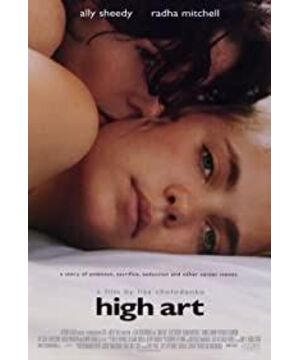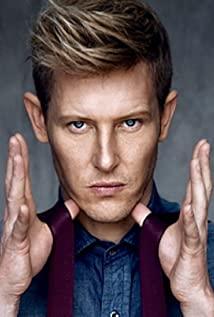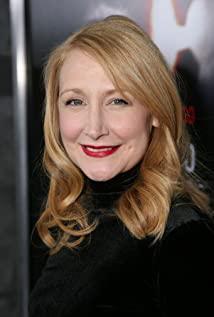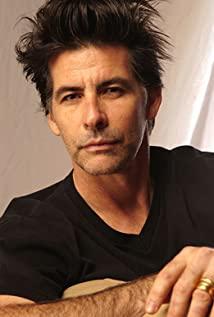At the Massachusetts Museum of Contemporary Art, I also watched an American movie "High Art". This film provides a rare reference for us to understand photography in contemporary art, to understand the production and operation mechanism of photography as an art category, and especially to understand the working conditions of contemporary photographic artists. "Pure Art" is very different from the fast pace of Hollywood. Instead, it is a bit like European films, especially French films, which focus on psychological performance. The film is slow-paced and, in Hollywood's terminology, "hypnotized." It just so happens that the interaction of the individual's psychological process with the impersonal group behavior under hypnosis is an aspect of photography in contemporary art, which also helps us understand photography through film.
"Pure Art" was launched in 1998 by the American "October Films" company (October Films), producer Dolly. Doly Hall, written and directed by Lisa. Lisa Cholodenko won the Special Jury Prize of the "Sun Dance Film Festival" that year. The heroine of the work, Syd, is composed of Australian rookie Ruida. Starring Radha Mitchell. Soder had just graduated from college and worked as an assistant editor at Frame, an influential photography magazine in New York. She studied cultural studies and critical theory in college, and was familiar with deconstruction, feminism, Derrida, Foucault, Kristeva, etc. This kind of professional background of the heroine has made a footnote for the conceptualization and theoretical tendency of contemporary art, and also provides an entry point for us to understand contemporary photography art. At the beginning of the film, Seder changed from an intern to an assistant editor. A female colleague asked her how she got this beautiful job and was promoted. Seder didn't know how to answer, but said that she had a theoretical background.
By chance, Seder met upstairs neighbor Lucy (Lucy Berliner, played by Ally Sheedy), and found that his residence had many well-taken photographs of people. When asked, Fang Zhi was photographed by Lucy. Seder had a good impression of Lucy, and felt that her works had psychological connotations, so he talked to her about his feelings. Lucy's answer was quite meaningful: "I haven't been deconstructed like this for a long time." Picture" editor-in-chief talked about Lucy, and brought a collection of Lucy's works to the editor-in-chief. The editor-in-chief and the magazine owner were surprised that Lucy was in New York. It turns out that Lucy was once a famous photographer in the United States. She suddenly disappeared from the film world more than ten years ago and mysteriously left Berlin, and the photography world gradually forgot her. Now that Lucy is back in New York, The Picture wants to re-launch her and put Seder in charge.
After Seder befriends Lucy, she discovers that Lucy is gay and has a decadent life, indulging in drugs and promiscuity with a group of depraved friends. Seid is a very enterprising and dedicated person. In order to do a good job, she disregards her boyfriend's misunderstanding and forces herself to join Lucy's circle. Not only does she take drugs, but she also sleeps with Lucy. The two seem to have fallen into the same sex. river of love. Lucy is a bit masculine, playing the gay dyke and living with her girlfriend Greta from Berlin. Lucy is also a person who pursues self-satisfaction. She originally pursued satisfaction in photography, and then got this satisfaction through drug addiction and homosexuality, so she looked down on art and moved to Berlin to live with Greta. Bring your girlfriend back to New York. Ever since she met the young Seder, she was attracted by her innocence, innocence and unusual sexiness, and Lucy fell in love with her, and the art in her heart gradually revived.
"Picture" decided to launch a special page for Lucy to publish her series of works, and treated Lucy very favorably. As for the content and form of the works, Lucy was allowed to decide by herself, while Lucy specified that Seder should do it in this issue of the magazine. own editor. Seid was determined to make the magazine well, and wanted to know what kind of work Lucy planned to shoot. She also offered to provide Lucy with a studio in the artist colony of New York to help her arrange equipment, find models, and so on. Lucy said that she never poses, only shoots improvised documentary works (spontaneous documentary), declined Seder's kindness, and did not tell her her vision for the work. Seeing that the deadline was approaching day by day, Seder was anxious, but Lucy remained silent. Instead, she traveled from time to time, as if she didn't care about the draft of "Picture". In fact, Lucy's heart is full of contradictions at the moment, she is struggling between returning to art and re-entering decadence, between Seder and Greta.
Sensitive Berlin girlfriend Greta sees Lucy's dissent, and threatens to commit suicide to confront her. At the same time, Seder kept urging the manuscript, so Lucy told Seder that she would return to Berlin with her girlfriend, but before leaving, she was going to her hometown in the northern suburbs of New York, and she invited Seder to go with her. In order not to let the magazine's publishing plan fail, but also for his own career and future, Seder agreed to travel with Lucy. So, at the country house, the two had a passionate bed scene. In the early morning of the next day, when Seder was about to wake up, Lucy photographed Seder sleeping in bed in the morning light and the passionate scene of the two of them.
After returning to New York, Lucy gave Seder two sets of works, Greta and Seder. That day happened to be the magazine's deadline, and Seder hurriedly handed over Lucy's Greta to the editor-in-chief. After reading the works, the editor-in-chief and the magazine owner were greatly disappointed, believing that this group of works had no intrinsic connection, no context, and was flat and completely incomprehensible. Obviously, this issue of the magazine is going to fail, and the editor-in-chief and the boss are very angry and very dissatisfied with Seder's irresponsibility. Seeing that his career and future are in jeopardy, Seder takes his heart out and takes out Lucy's passionate work in the countryside for him. The work was just released, and the editorial room was immediately filled with amazement. The editor-in-chief and the boss praised it as a famous work.
On the morning of the magazine's publication, Seder was surprised and saddened to learn that Lucy had died. Soder came to work in the editorial department and got the new magazine. Lucy's work for herself is published on the cover, and the middle page is also a large seder shot by Lucy, including the bed scene of the two. Both the editor-in-chief and the boss came to congratulate Seid and appreciate her work. At this time, the beautiful female colleague who asked her how to get promotion at the beginning of the movie looked at Seder with the eyes of "I finally understand", showing a self-smart expression to Seder's sadness.
The film Pure Art is both psychological and conceptual. Psychologically, Lucy struggled between art and decadence, she finally abandoned the decadent way of life and chose art. But the pain caused by this choice made her finally walk on the road of death. Seid also struggles between the two choices, but contrary to Lucy, she chooses depravity for the sake of art, dabbling in drug addiction and homosexuality, and finally achieves a successful career. The two are different in nature, but for the same purpose, they have experienced painful choices, but in the end they have different endings. As the saying goes, "people die for wealth, birds die for food". Although Lucy once gave up art, she was still an artistic animal in her bones. When art conflicted with her way of life, she finally chose art and went to death. Seder is also an artistic animal. For her own career and pursuit, she does not hesitate to try drugs and get involved in a homosexual triangle, so that her normal love will be destroyed. Lucy's first set of works failed because she gave up her Berlin girlfriend for art; the set of Greta-themed works, while impeccable in form, were bland in content and concept . Lucy's second group of works, with Seder as the theme, was full of passion because she turned to Seder and chose art. Her notion of art, a personal involvement in human relationships, is also implicit in it. In the movie, we see that her works are mainly about her relatives and friends, such as her mother and lover.
Therefore, the psychological content of the film is connected with the conceptual intention, which is found in the symbolic meaning of the characters in the play. Seder, the heroine, symbolizes contemporary art, characterized by a theoretical background. Her conceptual interpretation and admiration of Lucy's works is actually a deconstruction of Lucy. Her success came at the expense of Lucy's death. That is to say, conceptual art in the postmodern period, like a silkworm chrysalis, first entered into modernism, or emerged from within modernism, and then broke through. The reason why contemporary conceptual art can ascend to the dominant position in the art world is precisely because it bites the cocoon and ruins modernism, and finally stands out. Lucy symbolized the death of the avant-garde of modernism. She faded out of the art world more than a decade ago, symbolizing a farewell to the old avant-garde of modernism. When she returned to the New York art scene, her obsession with the young Seder led to a confluence with postmodern conceptualism. However, this confluence violated her past loyalty, so she had a conflict with her Berlin girlfriend, and finally ended in death. As for the Berlin girlfriend, she was so ill from drugs that even restaurants in New York were kicking her out of the house for her sleepy, pink face. Her symbolic meaning is dual. On the one hand, she represents the inevitable decay and decline of modernism in the postmodern period, and on the other hand, it reflects the context of contemporary conceptual art, that is, the declining modernism is the stepping stone of contemporary art. Therefore, in the eyes of the editor-in-chief of "Picture", the photography with the theme of this fallen woman does not have its own living conditions. This group of works is flat and worthless.
If Seid and Lucy respectively symbolize the present and past of pure art, then the editor-in-chief and boss of "Picture" symbolize the commercial nature of pure art in the post-industrial period, the art system in the West today, and the strategy The operating mechanism of exhibitors and cultural enterprises. Modernism of the past pursued the purity of avant-garde art with formal innovation, while conceptual art in the post-modern period was supported by contemporary philosophical theories and pursued the purity of conceptual art through social and cultural criticism. However, in today's commercialized society, a pure artistic concept cannot survive even one day, and contemporary art needs commercial operation. The selection of works by "Picture" magazine is actually a business operation. The context of works emphasized by the magazine is the social and economic conditions for the survival and development of cultural enterprises. An unimportant character who only appears at the beginning and end of the film, the clever female colleague who only cares about how to get promoted, symbolizes the common people who know nothing about contemporary art. These ignorant people are precisely the audience manipulated by the Picture and the art system, and they constitute the social basis for the acceptance of contemporary art.
The film Pure Art is an interpretation of contemporary art theory, contemporary art and photography today. My understanding of "Pure Art" reminds me of a similar German business card, Wings of Desire, shot by the famous director Wim Wenders in 1987. The film is an interpretation of modernist critical theory and modernist cultural phenomena. This is also a movie with a hypnotic function, which will make the audience fall asleep in the clouds. However, for those familiar with Lukács and formalist criticism, almost every sentence and every scene in this film has a theoretical source. In this sense, "Wings of Desire" is the same as "Pure Art", both of which are pure art in commercial films, both illustrate people's dedication to art and criticism, and both illustrate that "people are animals of art".
View more about High Art reviews











